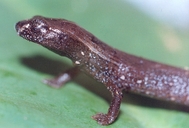|
Bolitoglossa minutula Wake, Brame & Duellman, 1973
Subgenus: Eladinea | family: Plethodontidae subfamily: Hemidactyliinae genus: Bolitoglossa |
 © 2009 Eduardo Boza Oviedo (1 of 7) |
|
|
|
Description Diagnosis: Small salamander with completely webbed digits. Varies in coloration from nearly uniform black dorsum to dull orange dorsum and dorsal surface of tail (Savage 2002). Description: Adults measure 54 to 76 mm in total length. Adult males measure 28 to 36 mm. in standard length, while adult females masure 30 to 37 mm in standard length. Tail length is moderately long, about 47 to 53% of standard length. Eyes are moderately large and slightly protuberant. There are 34 to 55 maxillary teeth in adults, and 15 to 40 vomerine teeth. In adult males, there are 1/2 to 2 costal folds between adpressed limbs, while in adult females, there are 2 to 4. Hands and feet are completely webbed, with subterminal pads present. Head width is 15 to 16% of standard length. In adult males, leg length is 21 to 24% of standard length, while in adult females, leg length is 25 to 27% of standard length (Savage 2002). It varies in color from being nearly completely black (or dark brown) dorsally, to a dull orange dorsum plus dull orange on the dorsal surfaces of the tail. Alternatively there may be a light brown field bordered by dark brown or black longitudinal stripes on each side. Venter is dark brown or black or spotted yellow and dark brown. Iris is pale brown (Wake et al. 1973). Distribution and Habitat Country distribution from AmphibiaWeb's database: Costa Rica, Panama
Life History, Abundance, Activity, and Special Behaviors Trends and Threats Possible reasons for amphibian decline General habitat alteration and loss Comments A Spanish-language species account can be found at the website of Instituto Nacional de Biodiversidad (INBio).
References
Savage, J. M. (2002). The Amphibians and Reptiles of Costa Rica:a herpetofauna between two continents, between two seas. University of Chicago Press, Chicago, Illinois, USA and London. Solís, F., Ibáñez, R., Savage, J., Wake, D., Chaves, G., and Bolaños, F. (2008). Bolitoglossa minutula. In: IUCN 2010. IUCN Red List of Threatened Species. Version 2010.1. www.iucnredlist.org. Downloaded on 14 May 2010. Wake, D. B., Brame, A. H. and Duellman, W. E. (1973). ''New species of salamanders, genus Bolitoglossa, from Panama.'' Natural History Museum of Los Angeles County - Contributions in Science, 248, 1-19. Originally submitted by: David Chen (first posted 2009-11-02) Edited by: Kellie Whittaker (2010-05-13) Species Account Citation: AmphibiaWeb 2010 Bolitoglossa minutula <https://amphibiaweb.org/species/3991> University of California, Berkeley, CA, USA. Accessed Apr 18, 2024.
Feedback or comments about this page.
Citation: AmphibiaWeb. 2024. <https://amphibiaweb.org> University of California, Berkeley, CA, USA. Accessed 18 Apr 2024. AmphibiaWeb's policy on data use. |



 Raffaëlli Account
Raffaëlli Account Map of Life
Map of Life